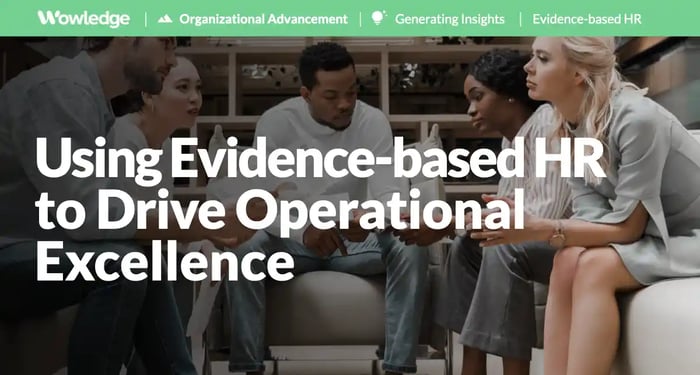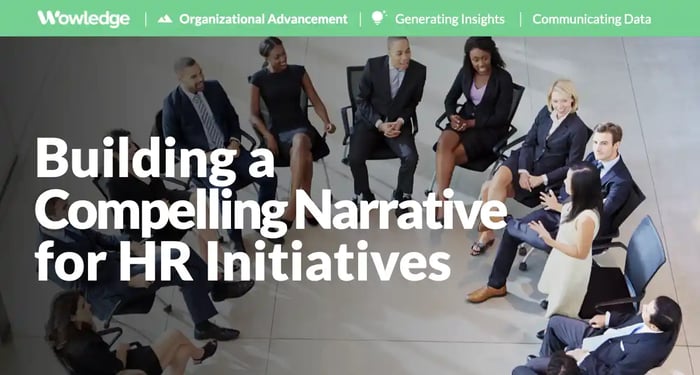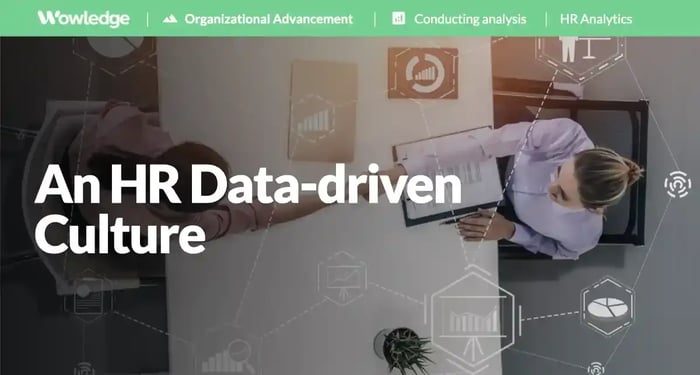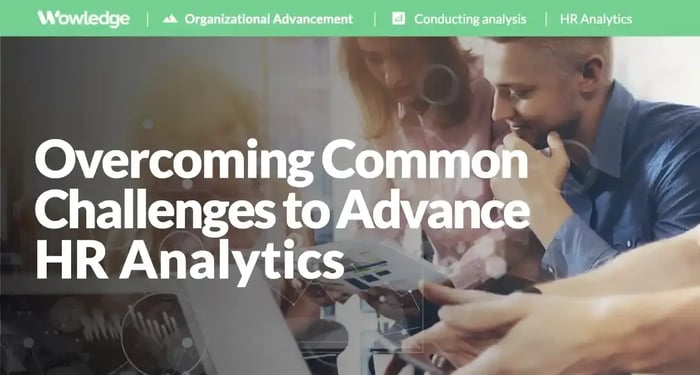When considering approaches to assessing and resolving HR challenges, there are many ways that teams can take action. These are based on the experience and professional maturity of a team or HR leader and tend to follow one of three general scripts. One is to simply take the surface approach and word of the observing HR team member or line manager and build a solution. The second is to take the time to collect relevant data and insights from those close to the issue and build a picture of the problem set to be resolved. A third is to review available data, collect local insights, compare those to external benchmarks for the situational assessment, and subsequently create an action plan for resolution. Evidence-based HR (EBHR) takes the approach to a new level of sophistication and objectivity.
The basis of those traditional approaches is most often driven by 1) a desire for a rapid response, 2) the presumption that the HR team has “been there, done that” before and therefore can expertly address the issue, 3) a need to minimize disruption of HR processes and work efforts and avoid a major and unplanned expenditure of time and resources. Unfortunately, such efforts too often deal with symptoms and do not address the root causes of problems that lead to their recurrence over time. Evidence-based HR offers a solution to such short-sighted assessment and resolution efforts.
What is evidence-based HR?
Evidence-based HR refers to an approach that emphasizes using empirical evidence to inform and guide HR practices and decisions. This approach replaces intuition, conventional wisdom, and unsystematic resolution development with data-driven insights and scientifically validated information. It is a disciplined, multi-source approach to 1) identifying and understanding talent issues that impact operational effectiveness and 2) creating objectively based solutions that achieve successful management and resolution of the issue. The main components of evidence-based HR include the proactive and integrated use of four sources of insight.
Scientific evidence. Empirically based, credible scientific, academic, and/or professional research developed using accepted standards for optimized objectivity and statistical validity. Relying on such insights provides an increased level of confidence that supports assumptions about the root causes and reasons an issue is occurring and possible solutions.
Integrated organizational data. Multi-source data from HR, payroll, financial, operational, sales, customer surveys, and employee listening systems. The value of such data is that it can be cross-referenced and integrated to achieve a broader understanding of the causes, reasons, and impacts of issues. Given a talent issue such as low productivity or high turnover might be due to people, process, technological, or environmental causes, leveraging a range of data and looking for cause-and-effect brings substantial power to resulting analyses. This requires advanced statistical tools and methods to ascertain an issue's “what” and “why” or related issues.
Expert judgment. Business and process experts bring deep experiential expertise and knowledge to the assessment. Careful selection of such experts, both inside and external to the organization, is an essential element of adding a more nuanced understanding of the elements of the problem and the likelihood of success for the resolution recommendations.
Stakeholder perspectives. This involves engaging the viewpoints and experiences of employees, managers, leaders, customers, applicants, and even the board of directors. It includes consideration of their preferences, expectations, and needs. This ensures that HR practices are effective and align with the organization's and its people's values and goals.
Bringing all these sources of information and insight together creates a uniquely powerful and comprehensive perspective on the challenges that business and HR leaders face on an ongoing basis. It can be used to assess and develop responses to either talent-related or contributions to business challenges such as turnover, low productivity, decreases in sales, recruiting shortages, etc.
The value of adopting evidence-based HR
Developing and deploying an evidence-based HR approach brings a new level of excellence to HR operations. It instills a disciplined and scientifically grounded mindset to understand what is happening and why. With more comprehensive data, the HR function can better understand the reasons for business performance shortcomings, which can drive better decision-making for solution-generation recommendations. It creates a higher standard for the HR team, with increased credibility from more fact-based, rational, and well-supported decision-making.
It offers the opportunity to reduce risk by basing decisions on more objective evidence and field-tested/proven practices. Relying upon the broader experience of other organizations and experts' precedents to understand and resolve pressing business issues is a well-established way to mitigate the risk of failure or misapplication inherent in any decision-making process. It can also offer a competitive advantage, with leaders knowing that many of their industry peers struggle to resolve similar issues with much less disciplined approaches.
The very nature of evidence-based HR encourages higher engagement from leaders and experts, who can influence internal perceptions and support solutions resulting from such efforts. By bringing them into the conversation, their understanding of the problem set is significantly enhanced, while collecting their insights and inputs can increase their sense of ownership over the problem and its resolution. Better solutions are available because they are based on a combination of the latest research-based insights with the full range of HR, business, and operational data, which often do not make it into the hands of HR teams. It supports the growth of HR capabilities, understanding that using evidence-based HR encourages continuous learning, agility, and adaptation to changing organizational environments while bringing a fresh perspective to solution creation across the function.

Similar concepts act as precedents
Other approaches have historically told us that evidence-based HR can be successfully adopted as a problem-solving approach. In fact, many of these were developed specifically with business applications in mind. The notion of taking a more holistic and scientifically sound approach to problem-solving is commonplace in fields such as medicine, pharmaceuticals, engineering, product design, and technology. However, as you will see, two notable examples of such an approach are firmly based in the HR realm but get much less press and coverage despite their success in both the assessment and solution development spaces.
The Scientific Method
The first methodology is also the oldest we learned in high school science classes – the scientific method. It is defined as a “systematic way of conducting experiments or studies so that you can explore the things you observe in the world and answer questions about them. First described by Francis Bacon and René Descartes in the 1500’s-1600’s, it calls for a systematic exploration of a phenomenon in such a way as to clearly understand what is happening and why. It involves a six-step process that includes:
- Define an observation or question
- Conduct research for previous related findings
- Generate a hypothesis or educated guess as to why it is occurring
- Test the hypotheses with a structured experiment
- Analyze the data from that experiment
- Develop insights or understandings about the reasons for or surrounding the phenomenon
This method brings discipline and structure to examining anything in the physical, psychological, chemical, and related realms. It allows for an objectively based comparison of experiments across researchers and research designs, enabling the observations of trends and cycles in occurrences and outcomes. As a result, its use and increased accuracy provide credibility to the findings.
Process Improvement
These methodologies are structured approaches to assessing workflows that help identify flaws and inefficiencies that impact the effectiveness of business processes. Often identified with engineering and technology work, these have been demonstrated to work exceptionally well with processes across all organizational functions, from finance to HR to manufacturing to marketing and sales. They utilize many tools and resources for hypothesis generation, data collection and analysis, and solution development. They commonly use process and outcome data, end-user/customer feedback and insight, and tools that engage the redesign team in free-flowing thinking about completing the process more efficiently and effectively.
Popular examples in the business world include Six Sigma, Lean, total quality management (TQM), and Kaizen. What they have in common is a formal process with steps that generally include:
- Define the real problem from an end-user perspective
- Map the current process
- Analyze for defects, unnecessary steps, inefficient hand-offs
- Clarify root causes
- Redesign the process, product, or system
- Monitor continuously
Again, notice that the focus is on a structured and disciplined approach to understanding the details of the process, opportunities for simplifying it, and redesigning it to meet customer needs.
Organization Development and Performance Consulting
Learning and development teams have been practicing these methodologies since the 1970s. They are designed to better understand a client group's needs and are focused on ensuring that they resolve a root cause (e.g., poor performance management), not a symptom (e.g., high turnover). The process ensures alignment around the true issues and drives a more objectively based solution set. The key elements of the methodologies include:
- Entry and Contracting – gain agreement on the problem to be evaluated and resolved
- Diagnosis and Assessment – use data, expert and end-user insights to determine the root causes of the problem
- Feedback and Planning – confer with the client to present findings and plan improvement strategies
- Intervention and Implementation – Design, develop, and pilot or implement the solution
- Evaluation and Monitoring – measure the outcomes and monitor the solution for effectiveness
Design Thinking
Used frequently in HR to improve the employee experience (EX), design thinking is an approach that is largely defined by its engagement with end-users of a process, practice, or program. It is noteworthy for its rapid prototyping approach, which seeks to quickly design, develop, and pilot test solutions that subsequently are subjected to improvement based on feedback. The steps will sound familiar by now:
- Empathize – research to understand end-users pain points and needs
- Define – users needs and problems
- Ideate – generate possible solutions and redesign elements
- Prototype – create an updated process, system, or program
- Test – run pilot tests and get user feedback, then tweak the design and re-test
Issues with implementing evidence-based HR
As with any structured improvement approach, barriers exist to HR’s use of more structured and evidence-based methodologies. Many of those are well-established and known to the HR community but require a shout-out as a reminder that they must be attended to when adopting and implementing evidence-based HR.
Lack of patience
EBHR requires time, resources, and planning to develop the specific approach, collect and evaluate data, assess options, and test and evaluate the results of pilots or full implementation. It is a fact of life that HR needs to plan carefully, assign resources, gain executive buy-in, and leverage change management strategies to guide the effort.
Leadership skepticism of HR’s abilities
An ongoing issue of HR’s credibility needs to be acknowledged and addressed. For example, KPMG reported that 49% of non-HR execs agree that HR leaders can demonstrate tangible correlations between people management initiatives and business outcomes, while only 25% said the HR function excels at proving the value of HR to the business. Additionally, it found that more than 35% of companies do not use advanced analytics or big data tools to improve their HR processes or look into the impact of their HR practices on business objectives. HR can struggle to gain acceptance for the approach without the demonstrated capabilities.
Lack or shortage of skills
Unfortunately, especially in data analysis, there continues to be a shortage of HR professionals with well-developed analytic capabilities. As analytics is not a requirement beyond basic statistics courses for many HR programs at the university level, new hires into the field are not helping build that capability. The experience participating in process improvement, Six Sigma, or design thinking projects will vary widely across industries and companies, leaving many HR professionals at a deficit in designing and implementing such efforts.
Low awareness and access to scientific research
Many organizations do not regularly subscribe to academic and scientific journals for the use of their non-technical staffers. Even for those who relied upon such resources due to their studying STEM-related disciplines, access to those is atypical once one leaves the academic community (e.g., college graduation). In addition, most HR professionals come from non-STEM backgrounds, and there exists a lack of knowledge, interest, understanding, and/or access to academic research that evidence-based HR relies upon. Even those interested in such insights are limited by paywalls, where a pay-per-article requirement exists.
Lack of trust in quantitative data vs. intuition
A bias for intuition and experience over quantitative evidence makes using hard data challenging for many professionals and executives. An interesting and apparent phenomenon of the human condition is a preference to rely on one’s experience and observations over hard data that may contradict one’s experience or perception of circumstances. Overcoming that is a challenge most HR professionals are aware of and used to, with line managers questioning findings from reports and surveys. The need to establish standards and buy-in from top leadership is crucial, yet many struggle to achieve both of those.
Cultural resistance
A general resistance to the use of formalized, objective data and insights, even when accompanied by inputs offered by experts (in and outside of HR) that support and align with the quantitative outcomes of an analysis. The effort it takes to create a culture of data and evidence-based decision-making can be substantial and is not as frequent a target for HR strategies as expected. Establishing HR as a provider of well-considered and planned assessment and solution development efforts takes time and energy that many organizations have not invested in.
Common HR measurement-related issues
As has been well-documented and reported, HR faces issues with data quality, non-integrated systems, HR analytic skills, technological shortcomings, etc. These are real threats to developing an evidence-based capability that continues to haunt many HR teams.

Implementing evidence-based HR
The key to implementing evidence-based HR is the structured approach to understand the problem, its scale and impact, and the root causes for its occurrence. For example, a common occurrence (as many an HR professional can attest) is a manager’s requested approach to dealing with high turnover in their department - a request for increasing pay scales – which research and employee feedback tell us is less likely the case. The issue needs to be clarified and delved into to develop a solution that is more likely to resolve it.
As a result, EBHR involves a six-step process that drives objectivity in the evaluation of a challenge as well as its correction. Those steps include:
1. Identify the problem or issue
Clarify the problem that requires resolution. Spend time with the stakeholders to understand the issue's nature, extent, urgency, and impact. Define it in detail (e.g., beyond "a turnover problem exists in Finance"). Align with leadership around the problem to be solved.
2. Research the problem
Collect data from all the available sources - scientific evidence, integrated organizational data, expert judgment, and stakeholder perspectives. Review HR reports, generate more detailed ones as needed, and review the most-cited academic research for insights into possible root causes of the problem. Interview experts from executive ranks, industry associations, and academic institutions and present the problem statement with any available data collected for their insights. Scan employee surveys and customer feedback, conduct focus groups, etc., to assess the issue from various viewpoints.
3. Evaluate the evidence
Which data or perspectives offer the most objectively reasonable and solid explanations for what is occurring (and why)? Which insights best apply to the organization’s situation, industry, workforce, and culture?
4. Compile the best evidence
Take the most valid and reliable evidence and integrate it into a cohesive narrative about the issue's nature, extent, and impact. Making it a clear and well-supported presentation will enable clear communications about what is occurring, why, and what can be done to deal with it effectively.
5. Generate a solution
Create a solution that addresses the issue's root causes and build a process that engages the stakeholders in its implementation. Establish change champions who can help push the solution through and drive adoption across the affected parts of the organization.
6. Evaluate outcomes
A key element of this process is relying on quantitative means for problem identification and resolution. Identify key performance indicators that address the original root causes – managerial behavior/skills, employee adherence to process redesign, organizational productivity, production output, etc. Measure and report on progress towards improvements to key stakeholders to keep all those involved in the assessment steps appraised and owning of the results.
Key implementation guidance for HR
Although this is primarily an HR-led methodology, it engages people across organizational levels and functions and, as a result, should be treated as a business intervention. It most typically drives improvements that can be tied directly to organizational efficiency, effectiveness, and success and, therefore, should be designed and promoted as such. evidence-based HR is also an HR capability development opportunity, so it should be viewed through that lens. To that end, some key elements that drive home the broad nature of that potential impact should be included to enhance the potential for success.
Train and indoctrinate the entire HR team
Individual projects will naturally require resources to collect and compile information from across the four primary sources of insight, and that will often engage the HRBPs, HRIS, HR strategy, HR Analytics, HR Shared Services, Compensation and Benefits, and other functional specialists. As such, employees across the spectrum of HR roles should be prepared to contribute to these efforts. Create a model/approach with steps that emphasize freedom from assumptions about the nature of the problem and solution until data is collected and processed. Standardized training should be created as a strategy and delivered before first-time participants start on a project.
Provide access to critical data and insights
Be prepared to provide project teams access to data, reporting, stakeholder perspectives, toolsets, external research, and knowledge bases. HRIS teams should be required to protect individual employees' personal information (PI) in reports and datasets provided to project teams. Consider creating alliances with local college/university professors and staff for access, education, upskilling, and project engagement.
Establish formal governance over projects
Establish formal oversight with a combination of business leaders and HR in an oversight committee, with membership depending on the nature and scope of the assessment and resolution effort. Build in decision-making related to when and how the full range of resources can be accessed and by whom to address the sensitivity of the data and protect the integrity of the assessment and solution-development work. This can support acceptance and ownership over the problem definition and subsequent resolution strategies that are developed.
Make appropriate investments
Be prepared to invest time, budget, and resources in developing employee skills and expertise, relevant tools and technologies, and time away from daily work duties. Ensure that team members and sponsors have sufficient understanding of the methodologies, analysis, and problem-solving ideation skills required to successfully implement such an effort. Make longer-term investments by actively seeking out HR job candidates (across roles and functions) who have backgrounds in social sciences, analytics, facilitation, surveying, data presentation, integration of qualitative and quantitative data, and even story-telling.
Require the use of the methodology
Finally, the methodology should be used for large-scale issue resolution and smaller ones by developing this expertise across the HR organization and supporting local teams applying its techniques. Reward local/functional HR leaders for using it to understand the base or root causes of issues and promote their efforts as prime examples of the approach over time.
Relevant Practices & Tools
Emerging HR Metrics and Reporting Practices to Drive Situation Assessment and Actionable Insights for Managers and Leaders. >
HR Metrics & Reporting is a standardized and structured experience for both developers and users of the data and reports. A crucial element is the development of a "data culture"... more »
Conducting Performance Consulting-based Learning Needs Assessments for Specialized Solutions. >
“Performance Consulting” is the act of resolving workplace performance shortcomings by using a disciplined approach to learning needs assessments... more »
Developing a Company-wide Culture of Data-based HR Decision Making. >
Producing reports is only the beginning. Many large and successful companies still struggle to make use of reports during decision-making a part of the widespread fabric of managerial... more »
Gathering, Analyzing, and Actioning Change Management Data to Clarify Needs and Measure Impact. >
Understanding how effective a change management strategy is with different stakeholder groups enables better engagement and the opportunity to adjust activities to better relate... more »
The Performance Consulting Assessment Tool: Uncover Workforce Challenges and Supporting Data for Learning and Development Solutions. >
The Performance Consulting Assessment Tool documents conversation(s) with functional managers who are facing specific workforce challenges that the learning & development... more »
About Wowledge
Wowledge is the expert-driven platform for lean teams building strategic HR programs. Members enjoy access to up-to-date best practices, step-by-step guides, tools, templates, and insights to accelerate the design and implementation of all key HR programs and processes.
Since each organization has unique characteristics, needs, and aspirations, Wowledge's practices are developed utilizing an exclusive stage-based approach – from Core to Advanced to Emerging – that reflects distinct levels of sophistication to meet our members where they are.
Build strategic HR programs with refreshingly easy-to-follow best practices.
Get started for FREE! Learn more.










